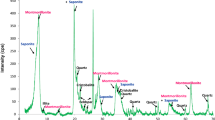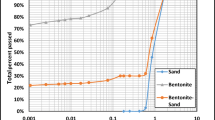Abstract
Thermal conductivity is an important parameter to consider when designing clay-based barriers for use in deep geological repositories (DGR). In the DGR environment, the infiltration of local saline groundwater can potentially change the pore fluid chemistry of a barrier over its lifetime. This change in chemistry is known to alter the thermal properties of the barrier materials. In order to examine the impact of pore fluid salinity on thermal conductivity, experiments were conducted under both distilled water and saline pore fluid conditions. The material mixtures were prepared at two different dry densities using two different salt types. Furthermore, five different thermal conductivity prediction models were selected and evaluated on their performance with respect to the experimental outcomes. In general, these results indicated that an increase in the constituent pore fluid’s salt concentration leads to a decrease in the thermal conductivity of the material. Additionally, the thermal conductivity values of the materials prepared at a high dry density were greater than of those compacted at a low dry density.








Similar content being viewed by others
References
Abu-Hamdeh NA, Reeder RC (2000) Soil thermal conductivity effects of density, moisture, salt concentration, and organic matter. Soil Sci Soc Am J 64:1285–1290
ASTM D 5334-14 (2014) Standard test methods for determining of thermal conductivity of soil and soft rock by thermal needle probe procedure, vol 04.08, ASTM, 100 Barr Harbor Dr., West Conshocken, PA 19428-2959
Balland V, Arp PA (2005) Modeling soil thermal conductivities over a wide range of conditions. J Environ Eng Sci 4(6):549–558. https://doi.org/10.1139/s05-007
Beziat A, Dardaine M, Gabis V (1988) Effect of compaction pressure and water content on the thermal conductivity of some natural clays. Clays Clay Miner 36(5):462–466
Börgesson L, Fredrikson A, Johannesson L-E (1994) Heat conductivity of buffer materials. SKB Technical Report TR 94-29. Stockholm, Swedish Nuclear Fuel and Waste Management Co.
Bruggeman DAG (1935) Dielectric constant and conductivity of mixtures of isotopic materials. Ann Phys 24:636–664
Casás LM, Pozo M, Gómez CP, Pozo E, Bessières LD, Plantier F, Legido JL (2013) Thermal behavior of mixtures of bentonitic clay and saline solutions. Appl Clay Sci 72:18–25
Chen SX (2008) Thermal conductivity of sands. Heat Mass Transf 44(10):1241–1246
Chen Y, Wang M, Zhou S, Hu R, Zhou C (2015a) An effective thermal conductivity model for unsaturated compacted bentonites with consideration of bimodal shape of pore size distribution. Sci China Technol Sci 58(2):369–380
Chen Y, Zhou S, Hu R, Zhou C (2015b) A homogenization-based model for estimating effective thermal conductivity of unsaturated compacted bentonites. Int J Heat Mass Transf 83:731–740
Cote J, Konrad J-M (2005) A generalized thermal conductivity model for soils and construction materials. Can Geotech J 42(2):443–458
De Vries DA (1963) Thermal properties of soils. In: Van Wijk WR (ed) Physics of plant environment. North-Holland Publishing Company, Amsterdam, pp 210–235
Dixon DA (1994) Sodium bentonites of Canada, the United States and Mexico: sources, reserves and properties. In: Crawford AM, Radhakrishna HS, Goutama M, Lau KS (eds) Engineering materials for waste isolation. Engineering Material Division Special Publication. Canadian Society for Civil Engineering (CSCE), Toronto, pp 37–65
Donazzi F, Occhini E, Seppi A (1979) Soil thermal and hydrological characteristics in designing underground cables. Proc IEEE 126(6):506–516
Farouki OT (1981) Thermal properties of soils (No. CRREL‐MONO‐81‐1). Cold Regions Research and Engineering Lab, Hanover
Ferrand T, Yvon J (1991) Thermal properties of clay pastes for pelotherapy. Appl Clay Sci 6:21–38
Fricke H (1924) A mathematical treatment of the electric conductivity and capacity of disperse systems. Phys Rev 24:575–587
Gens A, Sánchez M, Guimaraes LDN, Alonso EE, Lloret A, Olivella S, Huertas F (2009) A full-scale in situ heating test for high-level nuclear waste disposal: observations, analysis and interpretation. Géotechnique 59(4):377–399
Gori F, Corasaniti S (2002) Theoretical prediction of the soil thermal conductivity at moderately high temperatures. J Heat Transf 124(6):1001–1008
Graham J, Chandler NA, Dixon DA, Roach PJ, To T, Wan AWL (1997) The buffer/container experiment: results, synthesis, issues. AECL Whitesheil laboratories, Pinawa, Manitoba. AECL-11746
Haigh SK (2012) Thermal conductivity of sands. Géotechnique 62(7):617–625
Jamieson DT, Tudhope JS (1970) Physical properties of sea water solutions: thermal conductivity. Desalination 8(3):393–401
JNC (2000) Safety assessment of the geological disposal system. Supporting report 3. Project to establish technical basis for HLW disposal in Japan. JNC Tech. Rep., JNC TN1410 2000-004
Johansen O (1975) Thermal conductivity of soils. Ph.D. thesis, University of Trondheim, Trondheim, Norway. US Army Corps of Engineers, Cold Regions Research and Engineering Laboratory, Hanover, N.H. CRREL Draft English Translation 637
Kim CS, Man A, Dixon D, Holt E, Fritzell A (2012) Clay-based pellets for use in tunnel backfill and as gap fill in a deep geological repository: characterisation of thermal-mechanical properties. Nuclear Waste Management Organization, NWMO, TR-2012-05
Lu S, Ren T, Gong Y (2007) An improved model for predicting soil thermal conductivity from water content at room temperature. Soil Sci Soc Am J 71(1):8–14
Maak P, Simmons GR (2005) Deep geologic repository concepts for isolation of used fuel in Canada. In: Proceedings of the Canadian nuclear society conference on waste management, decommissioning and environmental restoration for canada’s nuclear activities: current practices and future needs, Ottawa, ON, 8–11 May 2005
Man A, Martino JS, Kim CS, Priyanto DG (2011) Characterization and improving the thermal conductivity of engineered clay barriers for sealing a deep geological repository. Waste Management, Decommissioning and Environmental Restoration for Canada’s Nuclear Activities, Toronto, Canada
Maxwell JC (1954) A treatise on electricity and magnetism. Oxford University Press, New York, pp 431–449
NWMO (2005) Choosing a way forward: the future management of Canada’s used nuclear fuel, final study. Annual Report, Nuclear Waste Management Organization, Toronto
NWMO (2015) Progress through collaboration—annual report. Nuclear Waste Management Organization, Toronto
Presley MA, Craddock RA, Zolotova N (2009) The effect of salt crust on the thermal conductivity of one sample of fluvial particulate materials under Martian atmospheric pressures. J Geophys Res Planets 114:E11
Rahimi S, Siddiqua S (2017) Relationships between degree of saturation, total suction, and electrical and thermal resistivity of highly compacted bentonite. J Hazard Toxic Radioact Waste 22:04017025
Ramires ML, Nieto de Castro CA, Fareleira JM, Wakeham WA (1994) Thermal conductivity of aqueous sodium chloride solutions. J Chem Eng Data 39(1):186–190
Russell SB, Simmons GR (2003) Engineered barrier system for a deep geologic repository in Canada. In: Proceedings of the international high level radioactive waste management conference, Las Vegas, Nevada, 30 March–2 April 2003. American Nuclear Society, La Grange Park, Il, pp 563–570
Sakashita H, Kumada T (1998) Heat transfer model for predicting thermal conductivity of highly compacted bentonite. J Jpn At Soc 40:235–240
Sarkar G, Siddiqua S (2016) Effect of fluid chemistry on the microstructure of light backfill: an X-ray CT investigation. Eng Geol 202:153–162
Sarkar G, Dey A, Siddiqua S (2016) Preparation of Wyoming bentonite nanoparticles. Environ Geotech. https://doi.org/10.1680/jenge.15.00001
Siddiqua S, Blatz J, Siemens G (2011) Evaluation of the impact of pore fluid chemistry on the hydro mechanical behaviour of clay-based sealing materials. Can Geotech J 48(2):199–213
Siddiqua S, Siemens G, Blatz J, Man A, Lim BF (2014) Influence of pore fluid chemistry on the mechanical properties of day-based materials. Geotech Geol Eng 32:1029–1042
Tikhonravova PI (2007) Effect of the water content on the thermal diffusivity of clay loams with different degrees of salinization in the Transvolga region. Eurasian Soil Sci 40(1):47–50
Villar MV (2002) Thermo-hydro-mechanical characterization of a bentonite from Cabo de Gata: a study applied to the use of bentonite as sealing material in high level radioactive waste repositories. ENRESA Technical Publication 04/2002
Wei J, Du Q (2013) Study of thermal conductivity and salt-heaving law of coast chalorine saline soil under multiple freezing and thawing cycles. J Chem Pharm Res 5(11):787–794
Wiebe B, Graham J, Tang GX, Dixon D (1998) Influence of pressure, saturation, and temperature on the behaviour of unsaturated sand-bentonite. Can Geotech J 35(2):194–205
Yu X, Zhang N, Pradhan A, Puppala AJ (2016) Thermal conductivity of sand-kaolin clay mixtures. Environ Geotech 3(4):190–202
Zhang N, Yu X, Pradhan A, Puppala AJ (2015) Thermal conductivity of quartz sands by thermo-time domain reflectometry probe and model prediction. J Mater Civ Eng 27(12):04015059
Acknowledgements
The first author would like to acknowledge the funding support from the Natural Sciences and Engineering Research Council of Canada (NSERC)/Discovery Grants Program (Grant # 62R09724) for this research.
Author information
Authors and Affiliations
Corresponding author
Rights and permissions
About this article
Cite this article
Siddiqua, S., Tabiatnejad, B. & Siemens, G. Impact of pore fluid chemistry on the thermal conductivity of bentonite–sand mixture. Environ Earth Sci 77, 8 (2018). https://doi.org/10.1007/s12665-017-7182-8
Received:
Accepted:
Published:
DOI: https://doi.org/10.1007/s12665-017-7182-8




